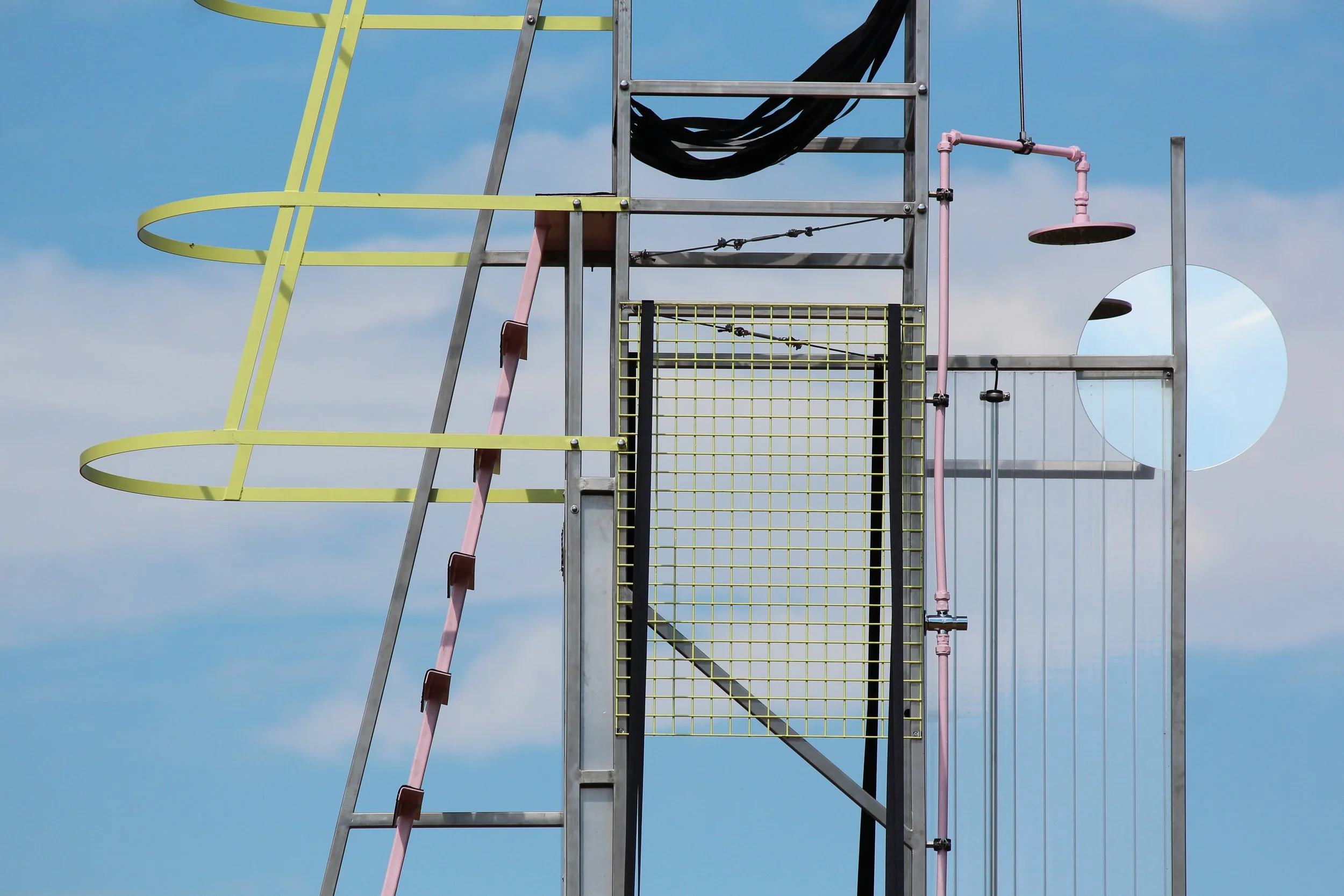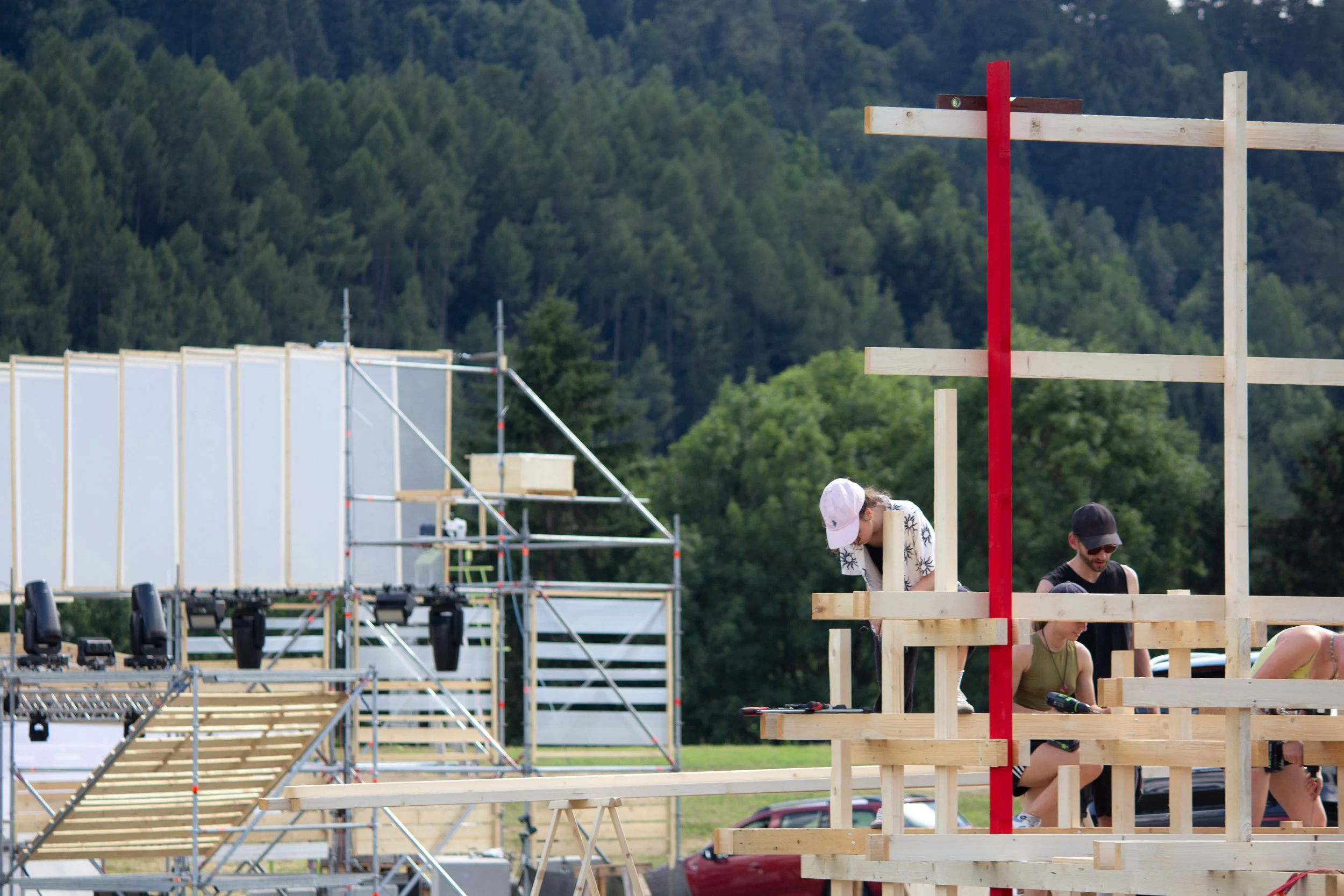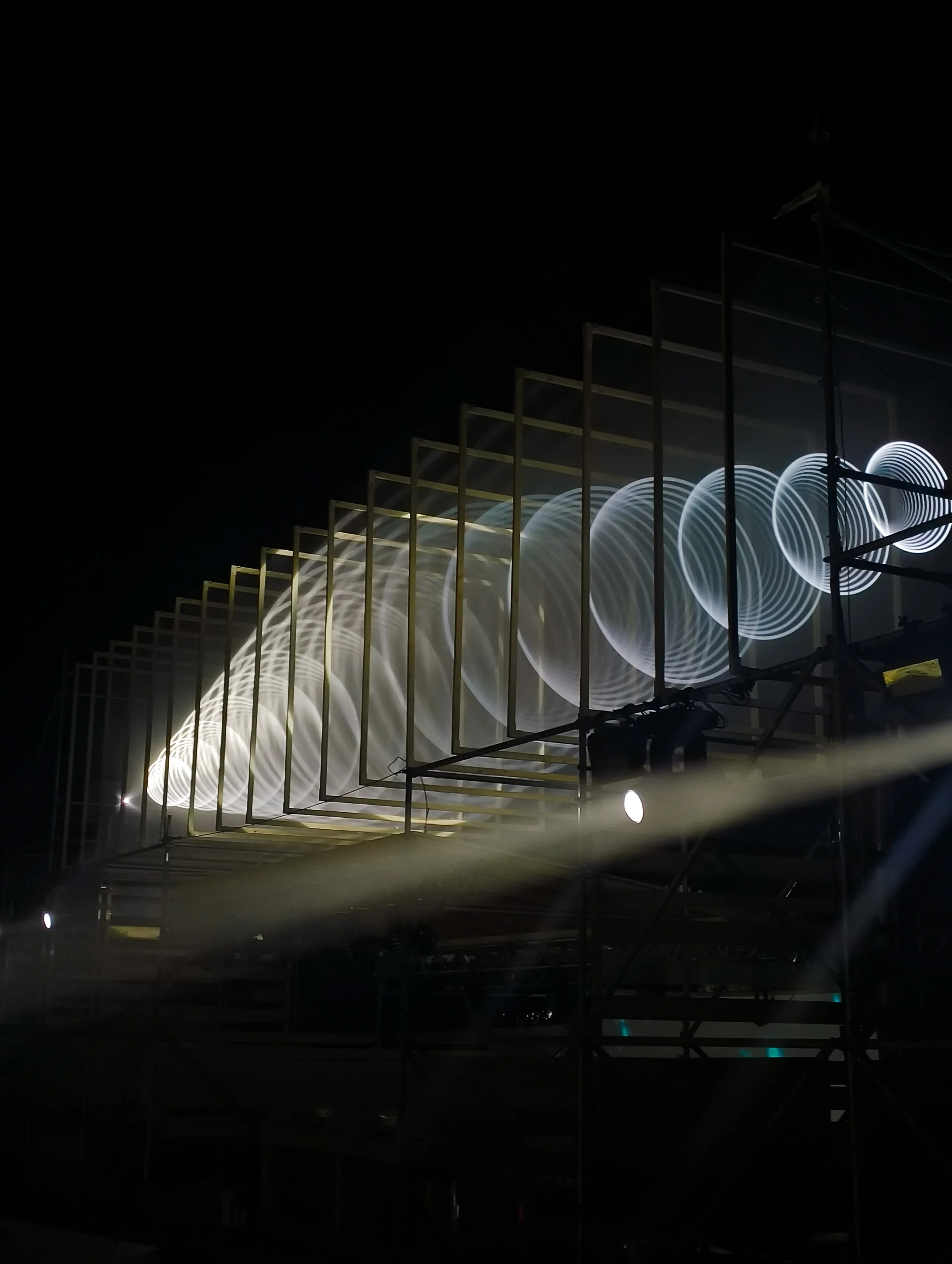Gabonsa
A Place in Transformation
“The transformation begins quietly. Someone carries, someone drills, someone discusses the grain of the plywood. What material should remain visible? How much shade is enough? Where will someone retreat later – or want to be seen?”
Photo: Susanne Oberhollenzer
An old driving range transforms. From a disused patch of land to a vibrant festival site – Gabonsa is more than music. It is a collective act of architecture. A spatial practice somewhere between construction and becoming. The transformation begins quietly. Someone carries, someone drills, someone discusses the grain of the plywood. What material should remain visible? How much shade is enough? Where will someone retreat later – or want to be seen? On the outskirts of Innsbruck, a former golf driving range becomes the setting for a festival that aims to be more than just a weekend of beats and bars. Gabonsa is an experiment. A site for new forms of gathering, for shared design, for temporary architecture.
Before the first light, before the first sound – there is conversation. Decisions about where to place a cable, how to orient a structure, or when to let a material speak for itself. For Hannes Steinkopf and Leon Stofft, part of the Gabonsa core team, the festival begins long before the site fills with people. What emerges here is not just a stage or infrastructure, but a spatial attitude: one rooted in collective thinking, improvisation, and care.
#1 An old driving range becomes a new festival – and maybe even a new kind of place. What makes you believe this transformation will take hold?
We’re working with a space that already carries a certain openness – both physically and mentally. The wide views, the leftover structures, the artificial-meets-natural landscape… it's like a blank canvas with traces from the history of this place. We believe transformation will take hold not because we erase what was there, but because we layer something on top of it – temporality, collectivity, experimentation. If the energy feels right, and the space resonates with people, it has the potential to become more than just a one-time event.
#2 With every scaffold, every screw, the site is changing – what kind of space are you trying to create beyond just infrastructure? And what challenges come with organising something from scratch?
We’re trying to build a space that feels both surreal and grounded – a place where people can lose themselves a little, but also feel held. It’s not just about sound systems or bars or stages; it’s about atmospheres, thresholds, rhythms, moments of pause.
The challenge? Everything. There's no blueprint, no “this is how it’s done.” We’re inventing logistics while also crafting visions for this place. It’s a huge balancing act between creative ambition and practical limits – time, budget, weather, neighbors, permits. But maybe that friction is part of what makes it alive.
Photos: Susanne Oberhollenzer
#3 Gabonsa is a first-time experiment – what do you hope will remain once everything has been taken down?
We hope what remains is a memory strong enough to return to – a shift in how people see the place, or what they believe a festival can be. Maybe it’s a friendship that started there. Maybe it’s the idea that abandoned spaces aren’t empty, but waiting. If we manage to leave behind a trace of possibility – in people’s minds, in the landscape, in the way we collaborate – then that’s something real.
Rising from the heart of the festival grounds, the Panorama Stage reveals its skeleton rather than concealing it. Built from wooden beams and Layher scaffolding, it doesn’t hide its structure behind decoration – it becomes the architecture. Under the direction of Max Knoblauch, the stage transforms from a functional support system into a sculptural, performative space: raw during the day, atmospheric by night, when projections and lighting create shifting visual narratives across its surfaces.
We spoke with Max Knoblauch about presence, process, and building with intention.
Panorama Stage, Photos: Susanne Oberollenzer
#4 You chose not to hide the structure of the stage, but to make it fully visible. What does it mean to you when the framework itself becomes the stage – not just functionally, but as a design statement?
The Heart of the Stage configuration comprises a series of room-shaping layers directed towards the viewer. Visitors are only able to observe parts of the stage from certain angles. If they view towards the stage itself, the background, which is the sky, is perceived as the stage.
Light animations are projected onto 18 parallel semi-transparent square layers of net suspended above the stage. During the day, these layers become windows in the sky, while at night they are transformed into Layers of digital light animations.
I think the structure is all about the main installation, but it doesn't go out of its way to make that effect bigger. So, it becomes a part of the installation, not something extra that's added to make it more advanced.
#5 The stage changes throughout the festival – through light, sound, and use. What does this transformation mean to you, and how do you design for such change?
I like the focus on the light in that question:
In a club - most people don`t value the work of an visual artist as much as the djing. I think that is poor - as the light and music are both waves having an immense effect on how we feel.
With the design, we focus on the connection of light and sound with in the surrounding. On a festival site we are outdoors, and the change of sunlight is a spectacle itself. as well as the music, that will be played.
The stage tryies to combine both in all facettes. Whether at night with fast sound or daytime and the sound of a violin.
So light and sound waves are leveled
Installation: Hannah Brod, Photos: Susanne Oberhollenzer
In her diploma work, Hannah Brod explores mechanisms of surveillance, perception, and public intimacy. Surveillance cameras, elevated structures, and light are reimagined not as tools of control, but as instruments of attention, observation, and disruption. Her work creates situations in which the boundaries between public and private space begin to shift – asking how visibility is shaped, felt, and negotiated. At Gabonsa, this spatial inquiry is tested for the first time in a collective, open-air setting.
#6 Your installation transforms surveillance into nature observation – cameras, light, and elevated viewpoints become tools of attention rather than control. Why is it important for you to provoke new ways of seeing, especially in analog, physical space?
I often describe the installation as a kind of trigger for discourse. With it, I wanted to draw attention to the silent observers (surveillance cameras) in public space – those that often go unnoticed but nonetheless exert a significant influence on our behavior. The entire work is based on the situationist method of “Détournement” *, which I have tried to translate into a contemporary context: to subvert critically regarded forms of restriction and give them a new kind of use.
The intention behind this installation was to reinterpret state surveillance – to reverse its logic and question its authority. Instead of enforcing control, I wanted to free people from their conditioned blinders and offer them the opportunity to direct their gaze toward previously overlooked details. As observers, people suddenly find themselves in an unexpected new role.
Through the ironic use of digital tools to observe the natural environment, I wanted to raise the question of whether, in the future, we will still be capable of perceiving analog spaces without the aid of a screen.
*Détournement (French for “rerouting” or “hijacking”) is an artistic strategy developed by the Situationists that recontextualizes existing cultural materials to subvert their original meanings and provoke critical thought.
Hannah Brod: Installation plans
#7 How does your work shift in a context like Gabonsa – a space that is temporary, public, and constantly observed and performed?
In the context of a festival, my work shifts in several ways, because the space itself changes – it is no longer every day, but curated and charged. This gives the installation a different presence. It no longer appears simply as an intervention in public space but becomes part of a larger staging. As a result, the focus shifts: it's less about the invisible aspects of everyday life, and more about making visible the structures that become especially apparent within this performative setting. At the same time, new tensions emerge – between art and audience, between private gaze and public space. Even here, the installation invites viewers to question their own perspective – but perhaps with a heightened awareness of being part of a larger staging.



Installation: Hannah Brod, Photos: Susanne Oberhollenzer
#8 With the raised structure, light, and shower, you're playing with the boundary between private and public. What happens, in your view, when intimacy becomes part of a collective setting?
Our understanding of space is shaped by unspoken rules about what should stay private and what can be shared. These boundaries usually go unquestioned. By placing a shower in a
public setting, the installation subtly challenges these conventions. Offering a place to wash in public raises important questions about access to basic needs and pushes back against the growing privatization of fundamental rights.
At the same time, nudity in this space removes visible markers of social status and hierarchy. Much like in a public swimming pool — where people from diverse social and economic backgrounds come together — clothing no longer enforces distinctions, and social labels lose their power. This creates a space where usual judgments are paused, allowing a moment of equality to emerge.
Hochschule Kaiserslautern, Photos: Susanne Oberhollenzer
As part of a design studio, interior students from Hochschule Kaiserslautern explored lightweight timber construction through a site-specific seating installation. What emerged is more than a place to sit: it is a modular, open form that invites rest, conversation, and temporary collectivity. Through minimal means and conscious material use, the structure subtly transforms the way people move through the space – and how they inhabit it, together.
#9 Your seating piece subtly transforms the way people move through and pause within the space. What kind of transformation were you aiming for – spatially, socially, or atmospherically?
Placed on a small hill, the pavilion serves as a spatial transition between two sides of the festival. On one side, it opens generously towards the main stage, allowing visitors to take in the vibrant atmosphere and energy of the event. On the other, a canopy made of aluminum vapor barrier and an orange construction net hammock offers privacy, a place to relax, and protection from the sun. This more sheltered side faces the quieter workshop area of the festival, where activities such as yoga will take place. In this way, the pavilion acts as a node, connecting different areas and providing a place for various people to pause, meet, and interact.
#10 Even small interventions can shift how a place is experienced. How do you see your installation contributing to the overall transformation of the festival site?
The festival site is expansive, and objects can easily get lost within it. The reflective semi-circle catches the eye from a distance, creating a small point of reference and helping visitors orient themselves among thevarious workshops, bars, and installations.
Hochschule Kaiserslautern , Photos: Susanne Oberhollenzer
Light gives a festival its rhythm, its tension, its magic.
For Gabonsa, Kuntergrau (Linus) and Perspek.steven (Steven) developed a lighting concept that extends across the site and culminates in the MainStage, where it merges with their live visual set. As a long-time duo, they are known for VJ performances that blend depth and intensity, creating synesthetic experiences in which sound, image, and space become one fluid composition. Here, light is more than illumination – it’s architecture, atmosphere, and live presence all at once.
Photos: Kuntergrau.visuals + Perpek.steven
#11 Your lighting doesn’t just illuminate the space – it shapes how it’s perceived and experienced. What role does light play for you in defining the atmosphere of a temporary setting like this?
Light plays a crucial role in our work. With a shared background in architecture, we approach our practice as digital artists by designing spaces that create a strong sense of atmosphere and immersion. For us, light is never just about visibility or illumination - it is a spatial medium. Especially in a temporary setting like this festival, it becomes essential in shaping how people perceive and move through space.
During the day, we are lucky to have this beautiful natural backdrop. The mountains and landscape around Innsbruck already provide a strong presence. But as soon as it gets dark, light becomes our main tool to create something different - something immersive and memorable.
Light can set the mood instantly, and change it just as quickly. It is a way of revealing surfaces and areas that might otherwise go unnoticed. It allows us to highlight what is hidden, reframe the space, and give it a new identity for the night.
#12 The installation extends into the Panorama Stage, where it becomes part of your live visual set. How does this fusion of light and performance influence the way you approach spatial design?
Interactivity is a central part of our work. It is a core principle in how we think about design and spatial experiences. We are creating environments that react based on their surroundings, where people are not just passive observers but become active contributors.
The installation we created for Gabonsa is called ARRAY. It consists of vertically arranged frames, each stretched with a fine, transparent fabric. The mesh layers allow light to pass through, giving it a volumetric quality, almost like sculpting light in mid air. Two projectors, one from each side, beam through the layers, activating the space with depth and dimension.
Key part of the installation is a motion sensor that tracks the position and movement of people’s hands, allowing them to shape the light directly. It creates a live connection between the audience and the space, between technology, user and environment.
The concept of the ARRAY installation was also adapted in the design for the panorama stage, which was an exciting opportunity for us to bring a new form of audio reactive and spatial design to the dance floor. This second version is driven by audio input coming directly from the performing artists. The sound itself becomes the input, driving the visuals, which are generated and manipulated in real time, interacting with the light and expanding the spatial experience.
Being able to respond to music in real time allows us to shape not only the visual atmosphere but also the mood, energy and tempo on the dance floor.
Photos: Susanne Oberhollenzer
Links
website: https://gabonsa.com/
Instagram: @gabonsa.festival
Photo Credits: ©Susanne Oberhollenzer, Kuntergrau.visuals + Perpek.steven
Interview by Susanne Oberhollenzer

































